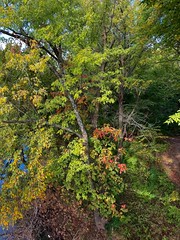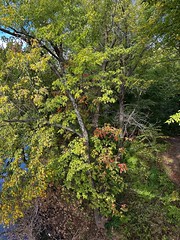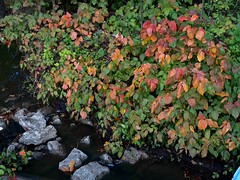I awoke in Santa Fe, had an uninspiring continental breakfast in the cramped lobby of the hotel complex, and set out for the hills to the northeast, hoping to hike part of the Dale Ball trail system. But alas, the entire system is closed, like the adjacent forest, because of the fire danger. I do wish the city’s webpage on the trail system would bother to mention that.
So I drove around the hilly residential area and finally settled on Hillside Park as a destination. I circled the park, but could not find a parking area – it turns out the one up top has been blocked off for unknown reasons. But I managed to find Thomas Silvestri Macione Park near the base of Hillside Park, and it had plenty of parking.
The tiny triangular plot of land is dedicated to Mr. Macione, or “El Diferente”, who was evidently a beloved eccentric who started out as a barber in Boston but moved to Santa Fe in 1952 to paint. A sculpture of El Diferente by Mac Vaughan, complete with easel, palette, and nearby dog, adorns the park.
I found the lower entrance to Hillside Park, which is a plaque-adorned series of ramps leading up the hillside. Ascending the walkway afforded a nice view of downtown and the Plaza a few blocks away, and a rabbit entertained me for a bit.
Up top the trail led to a monument with the figure of Justice on one side. It turns out the upper area was L. Bradford Prince Park, commemorating a territorial governor who was instrumental in early policies; the whole area was once part of Fort Marcy. Tiny lizards skittered by here and there. The city had started some trails across the park, but they were abandoned and incomplete. I wandered the area, reaching a nice home adjacent to the park at far end, and retraced my steps, catching sight of the Romanesque towers of the Cathedral Basilica of St. Francis of Assisi above the trees. I toured the Cathedral last year, but I would see it from the Plaza today as well.
Driving to the Plaza area, I searched for a street parking spot but finally gave up and grabbed one in a parking garage. I toured the New Mexico Museum of History and the Palace of the Governors, which is an ancient, long, and narrow adobe building dating back to 1610 and said to be the oldest continuously occupied public building in the U.S. Its current Pueblo Revival Style appearance dates back to a 1913 renovation and that look became mandatory for buildings throughout Santa Fe. It gives the city a unified distinctive appearance, even though it is mostly faux-dobe. Few buildings here have four-foot-thick walls build of mud bricks like the Palace.
Today the building, like the Spanish Governor’s Palace in San Antonio, is anything but what we think of as palatial. It seems like a fairly miserable place to be stuck in to me, spoiled as I have been by 20th and 21st century architecture and resources. I was struck by the small size of the chain mail on display used by Spaniards back in the day – even I would be heavier and taller than them thanks to modern nutrition. Photos were banned in the complex, but I did shoot the courtyard between the buildings. The white low structure on the right is the Palace. I also strolled out into the plaza and shot the front veranda, lined as always with Native Americans selling wares.
I’d hoped to eat at the famous Plaza Cafe, but it was closed pending clean-up from a kitchen fire. The receptionist at the museum suggested Tia Sophia’s, but it was closed too. So I strolled over to the La Fonda hotel, which was built in 1922 and was one of Fred Harvey’s famous hotels from 1925 until 1969. I’m not surprised that the impressive interior reflects the design work of Mary Colter, who helped create so many splendid buildings at the Grand Canyon and established a style now used throughout our national parks. I enjoyed a drink up in its bell tower last year.
In the 1970s the hotel’s interior fountain patio was enclosed and turned into the La Plazuela restaurant. It was fully renovated in 2009 when local architect Barbara Felix painstakingly reworked it. I was impressed by her attention to detail, even visiting the closed mine to get samples of the original flagstone material for a better match. I honored her work by dining at La Plazuela today, waiting until 11:30 for lunch to begin.
I was not disappointed. The beef fajitas I had tie with those at La Rosa in Bend, Oregon as the best I’ve ever had. While the grilled squash and other vegetables were what made La Rosa memorable, in this case the excellent slices of meat were served with delicious corn, pinto beans, and exquisitely cooked sweet onions and peppers. Nothing very unusual, outside of the corn, but these were prepared to perfection. And topping it off was a thick hot sopapilla and honey. I had enjoyed a similar meal at Enrique’s in Ponca City last week, but La Plazuela showed just how wondrous fajitas can be when skillfully prepared.
I waddled about the hotel for awhile, admiring the light fixtures, alcove paintings, and fireplaces. Back outside, I strolled down to the Cathedral, drawn by its bells striking 12:45 p.m. and its statuary, and was struck by a multi-figure statue in the park with both animals and people. An art show was going on, but I still got shots of the four major figures and a cathedral tower in the background, and the tower viewed amidst the park’s trees. The museum across the street from the cathedral, in the renovated Federal Building, is a nice example of Santa Fe style.
I wandered over to another art show, this one by the Santa Fe Society of Artists. I went in not expecting to buy a thing, but the penultimate booth was that of Franz Amadeus Leitner, and his landscape photographs were most striking. I especially liked a shot of Shiprock, a formation in northwestern New Mexico I have not visited but plan to see for myself next week. I liked it enough to splurge and buy the mounted print for my home. Mr. Leitner was charming and I enjoyed how he plugged a tiny swiper into his iPhone for my credit card.
On my way to my car with my bubble-wrapped treasure, I was stopped by three ladies who were looking for a yogurt shop. My own iPhone was used this time to give them walking directions, and as soon as they went on their merry way I was asking it for help too, since I’d told it to remember where my car was parked.
The next stop was Museum Hill, which I visited last year during the International Folk Art Festival. It was far quieter today, and the empty plaza highlighted the large Apache Mountain Spirit Dancer sculpture by Craig Dan Goseyun. I love how he captured the movement of the dancer’s costume. Nearby was Morning Prayer by Allan Houser, who also sculpted Sacred Rain Arrow at the Gilcrease Museum in Tulsa.
I made a sandwich of the area, with boring slices of the Museum of Indian Art & Culture and the Museum of Spanish Colonial Art around the meat of the Museum of International Folk Art. Lucky for you, only the meaty museum allowed photography. A docent took me and an elderly couple from New York to highlights of the extensive collection of folk art. My favorite was the Girard collection, a sampling of about 10% of the 100,000 pieces Alexander Girard collected and donated, setting up clever displays and tableaus. I liked the Polish cathedrals decorated with silver foil from candy wrappers, a South American cathedral, a Mexican courtyard tableau, and loved the addition of some camera-laden elderly tourists in the huge pueblo tableau. I also admired the costumes in another wing from a Bolivian Carnival and Peruvian Masquerade.
It was too late in the day to visit the fourth and final museum on the hill, the Wheelwright, so I drove over to the Cristo Rey Church, which is the largest adobe church in the world. Making my way over to the Monsignor Patrick Smith Park, I spotted a bell just like the one my father has on a pole in his backyard. This one was handsomely mounted above a gate in an adobe arch.
Folks were lounging under the few trees around the edges of the park, some with children and some getting randy enough that they’ll have children in no time. My final shot of the day was of a home perched on a distant hillside.
I returned to my hotel to map out, literally, my strategy for the next couple of days and then had spaghetti and meatballs at the Olive Garden. Tomorrow I’m going to Bandelier National Monument, which had been completely closed for a few weeks due to the Los Conchas Fire. Frijoles Canyon is still closed indefinitely, with fears of flash flood damage in the coming rains. But last Friday they opened up three trails around the north edges of the park and I’ll take anything at this point since all of the forests and city trails are shut down. I had fun in town today, but I’m ready to head out to the countryside for a day hike.







Dear Mr. Meador,
Thank you so much for your kind words, it was a pleasure meeting you at my art show. I’m honored that you have chosen to include my photograph of Shiprock in your art collection. I hope this print, one of my favorites, brings you joy and good memories of New Mexico for many years to come.
Until next time,
~Amadeus Leitner